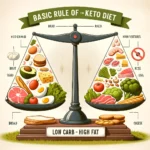Mastering Keto Macros: Essential Guide for Optimal Results
Introduction to Keto Macros
The ketogenic diet is renowned for its unique macronutrient composition, pivoting away from traditional diets high in carbohydrates. Understanding and managing these macros—fats, proteins, and carbohydrates—is crucial for success on this diet.
Breaking Down Keto Macronutrient Ratios
High Fat, Moderate Protein, Low Carbohydrate
- Fats: Typically constituting 70-80% of total daily calories, fats are the cornerstone of the keto diet. They are the primary energy source in the absence of carbohydrates.
- Proteins: Making up about 20-25% of daily caloric intake, proteins are essential for muscle maintenance and overall health. However, excessive protein can hinder ketosis.
- Carbohydrates: Limited to about 5-10% of daily calories, which usually translates to 20-50 grams per day. This restriction is key to maintaining ketosis.
Calculating Individual Macro Needs
Tailoring Macros to Personal Goals
- Weight Loss vs. Maintenance: Caloric and macronutrient needs differ based on whether you’re aiming for weight loss or maintaining your current weight.
- Activity Levels: More active individuals may require slightly more protein and carbs.
Tools and Methods
- Keto Calculators: Online tools can provide a personalised macro breakdown based on your age, gender, activity level, and goals.
- Professional Guidance: Consulting with a dietitian can ensure your keto macros are aligned with your health needs and goals.
The Role of Each Macronutrient in Ketosis
Fats
- Serve as the primary energy source, replacing carbs.
- Sources include avocados, nuts, seeds, olive oil, and fatty fish.
Proteins
- Essential for muscle and tissue repair.
- Should be consumed in moderation to avoid disrupting ketosis.
Carbohydrates
- Limited intake is critical to stay in ketosis.
- Focus on fibre-rich, low-carb vegetables like leafy greens.
|
Tips for Macro Tracking
Keeping Track
- Use food tracking apps to log daily intake and ensure you’re meeting your macro targets.
Adjusting as Needed
- Regularly assess your progress and adjust macros if you’re not achieving desired results.
Mindful Eating
- Pay attention to how different foods affect your body and ketosis status.
Conclusion

Effectively managing keto macros is more than just following a diet; it’s about understanding how your body uses different nutrients to function optimally while in ketosis. By calculating your individual needs, understanding the role of each macronutrient, and tracking your intake, you can tailor the ketogenic diet to your personal health and wellness goals, ensuring a successful and sustainable journey.

Advanced Strategies for Optimising Keto Macros
Fine-Tuning Your Diet for Enhanced Results
Periodic Reassessment
- As your body adapts to the ketogenic diet, your macronutrient needs may change. Regular reassessment ensures continued effectiveness.
Responsive Adjustments
- Be responsive to signals from your body. If you experience low energy or other symptoms, consider tweaking your macros.
The Importance of Quality in Macro Sources
Selecting High-Quality Fats
- Prioritise healthy fats like omega-3s from fish, monounsaturated fats from olive oil, and medium-chain triglycerides (MCTs) found in coconut oil.
Choosing Lean Proteins
- Opt for high-quality proteins like grass-fed meats, free-range poultry, and wild-caught fish.
Smart Carb Choices
- Emphasise low-glycemic vegetables and small portions of berries for your carbohydrate intake.
The Interplay Between Macros and Exercise
Adjusting Macros for Activity Levels
- Active individuals may need more protein for muscle repair and a slight increase in carbs on workout days.
Timing of Macronutrient Intake
- Align your intake of certain macros, particularly carbohydrates, around your exercise schedule for optimal energy and recovery.
Beyond Macros: The Role of Micronutrients
Ensuring Nutritional Adequacy
- Pay attention to vitamins and minerals. Supplements like magnesium, potassium, and vitamin D may be necessary to compensate for dietary restrictions.
Hydration and Electrolytes
- Maintaining hydration and electrolyte balance is crucial, especially during the initial stages of the diet.
Managing Social and Psychological Aspects
Social Dining and Keto
- Navigate social situations by planning ahead and choosing keto-friendly options.
Psychological Implications
- Be mindful of the psychological impacts of a strict diet. Balance discipline with flexibility to maintain a healthy relationship with food.
Conclusion
Mastering keto macros is a dynamic process that extends beyond mere numbers. It involves understanding the quality of food sources, being responsive to your body’s needs, and considering the psychological and social aspects of dietary changes. By adopting a holistic approach that includes regular reassessment, quality focus, and alignment with lifestyle, you can optimise your ketogenic journey for better health, increased energy, and overall well being. Remember, keto is more than a diet—it’s a lifestyle that requires adaptation, learning, and a commitment to long-term health.
Integrating Keto Macros into a Sustainable Lifestyle
Building a Long-Term Keto Plan
Flexibility Within Framework
- Incorporate a degree of flexibility in your diet to adapt to different situations and prevent burnout.
Realistic Goal Setting
- Set achievable and realistic goals for weight loss, health improvement, or maintenance, which encourage adherence to the keto diet.
The Role of Intuitive Eating
Listening to Your Body
- Pay attention to hunger cues and energy levels. Adjust your macro intake accordingly to align with your body’s needs.
Mindful Eating Practices
- Practise mindful eating to enhance your connection with food, improving both satisfaction and dietary adherence.
Overcoming Common Hurdles
Addressing Plateaus
- If weight loss or health improvement plateaus, reassess your macro balance and consider potential dietary adjustments.
Managing Cravings
- Find keto-friendly alternatives to satisfy cravings and maintain a state of ketosis.
Continuous Education and Support
Keeping Up-to-Date with Research
- Stay informed about the latest developments in ketogenic diets to refine your approach continually.
Seeking Community and Support
- Engage with keto communities online or in-person for support, recipe sharing, and motivation.
Conclusion
Navigating the world of keto macros is a journey of personalization, adaptability, and continuous learning. By understanding the critical role of macros in the ketogenic diet, responding to your body’s cues, and integrating flexibility and mindfulness into your approach, you can sustain this lifestyle long-term. Embracing the keto diet is not just about adhering to specific macronutrient ratios; it’s about making informed, healthful choices that align with your individual goals and lifestyle, leading to improved well-being and satisfaction. Remember, the path to success on a keto diet is paved with education, support, and a commitment to holistic health.
Embracing a Holistic Approach to Keto Macros
Balancing Keto with Overall Wellness
Holistic Health Considerations
- Recognize that true wellness extends beyond diet. Incorporate aspects of mental, emotional, and physical health into your keto journey.
Stress Management
- Manage stress effectively, as it can impact dietary choices and overall health. Techniques like meditation, yoga, or regular exercise can be beneficial.
The Importance of Sleep in a Keto Lifestyle
Sleep and Metabolic Health
- Ensure adequate sleep, as it plays a crucial role in metabolic function and the body’s ability to maintain ketosis.
Strategies for Better Sleep
- Develop a regular sleep routine and create a sleep-conducive environment to support your keto lifestyle.
Advanced Nutritional Tactics
Exploring Keto Variations
- Consider experimenting with different forms of keto, such as cyclical or targeted ketogenic diets, to better suit your lifestyle and goals.
Nutrient Timing and Keto
- Investigate the timing of nutrient intake. Consuming certain nutrients at specific times can optimise energy levels and workout performance.
Beyond the Diet: Lifestyle Integration
Incorporating Regular Physical Activity
- Align your exercise routine with your ketogenic diet to maximise health benefits and performance.
Mindful Lifestyle Choices
- Make conscious choices about lifestyle habits that impact your health, such as reducing alcohol consumption and avoiding processed foods.
Lifelong Keto Journey: Adaptation and Growth
Evolving with Changing Needs
- As your body and lifestyle change, be prepared to adapt your keto approach. What works today may need adjustment tomorrow.
Continuous Learning and Experimentation
- Embrace a mindset of ongoing learning and experimentation. Stay curious about new research and be open to modifying your approach.
Conclusion
Successfully managing keto macros is about much more than just following dietary guidelines. It involves a holistic approach that encompasses physical, mental, and emotional health. By integrating keto into a comprehensive lifestyle that includes stress management, quality sleep, regular physical activity, and mindful living, you can create a sustainable and effective pathway to long-term health and wellness. Remember, the ketogenic journey is unique for each individual; it’s a process of discovery, adaptation, and continual growth. Embrace the journey with an open mind and a commitment to holistic health for the best possible outcomes.








